Replacement Trailer Hub Bearing - LM67048

Thank you! Your comment has been submitted successfully. You should be able to view your question/comment here within a few days.
Error submitting comment. Please try again momentarily.
- All Info
- Reviews (182)
- Q & A (0)
- Videos (2)
- Photos
etrailer Trailer Bearings Races Seals Caps - LM67048
- Bearings
- Standard Bearings
- 5000 lbs Axle
- 6000 lbs Axle
- Bearing LM67048
- etrailer
- Race LM67010
High-quality, tapered roller bearing is designed for high-speed use. Replacement part uses industry-standard number.
Features:
- Inner diameter: 1.250"
- Matching race (sold separately): LM67010
- Application: outer bearing for 8-201-5 and 8-213-5 hubs
- Equivalent to Dexter part 031-032-02
LM67048 Replacement Bearing
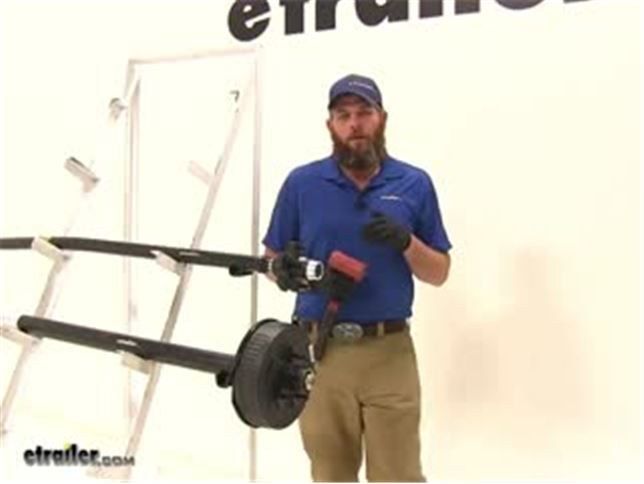

Videos are provided as a guide only. Refer to manufacturer installation instructions and specs for complete information.
Video Transcript for Trailer Bearings Races Seals and Caps Rebuild
Speaker 1: Today we're going to take you through the rebuild process on a couple of hubs. We've got an idler hub, and here we've got a hub and drum assembly. Works with electric rigs, but this can also work for just standard discs, if you've got a disc brake style setup.Basically what we're going to show you is how to get all of the bearings out. How to remove the seal. How to remove the race's if they're damaged, then get them replaced in the proper manner. We'll show you how to use an easy loop hub, which we have here.The first thing we are going to need to do is, get the grease cap off the end.
It can have either a rubber plug in it like this one does, or it can be a solid metal cap.These are pressed fit in there, basically by tapping on them on the back side. To remove them, a deadbolt hammer is typically what we're going to use. We're just going to start tapping as we go around. You'll see a little separation start right here, and slowly it'll work it's way off.Now the next step's going to vary a little bit depending on your axle setup. Do you see this is going to have a keeper that goes around the nut.
And that prevents that from being backed off, or removed. A lot of times you'll have a castle nut, which will have just little tabs that stick off, and there will be a cotter pin that passes through it. Just depending on your application, you need to get the keeper for the nut off. This style we just kind of pry out. A cotter pin you would just remove of course.Once we have that off ...
We'll start to take off the nut here, and the washer that's in behind it. Now yours should look a whole lot more dirty than this. There should be a lot of grease packed in, and through the hub, this one's brand new. We thought it'd be nice to show you the components before the grease was on .. Of our washer that comes off.And then here we're going to have our outer bearing.
Continue to pull that. We're gonig to have our inner bearing here. That sits in the backside of the hub. And we didn't put it in yet, we will show you how to put it in. But a seal would typically be covering the backside here. We'll show you how to use a seal removal tool, or another tool. To get that pried up and out. To get an access to that inner bearing.Now for a drum style like this, that process for disassembly is going to be just the same. One thing to keep in mind if you're using a disc brake setup. You'll have to remove the caliper before the disc is going to come off.Now once we have the spindle exposed, as we said this is going to be really greasy. We want to get all the grease removed, and the first thing we'll do is inspect it. We want to make sure that it looks just like what we have here. Everything's nice and smooth. We don't see any kind of discoloration, or any marring on the metal. Indicating that our bearing's got hot.If you do have any of those symptoms, at this point it's time to replace those bearings. You don't want to repack them. Get new bearings, and put in there. You might have a bearing that's come apart in here. Another surface to ensure is in good condition, is where your seal is going to go. That helps seal all the grease inside of our hub. With a damaged or broken seal, that grease is going to seep out. Either out of the hub, or in this case into our brake assembly.Now if your axle has brakes, we're also going to check the disc. Make sure it doesn't have any issues, or your hub. And this is going to be a hub and drum assembly. The brakes are going to ride on this machine surface. You're going to check that for signs of excessive heat, discoloration, or cracking. And this is our magnet surface. We'll check that surface for the same issues.Now inside the hub regardless if it's a disc brake, it's a drum brake like this. Or just a standard idler style hub. You're going to have an outer race. Would be right here, it's a small tapered piece of metal your bearing sits in, and rotates on. That's basically the outer portion of the bearing.You have the same thing here on the backside. This is called the inner race. Now if those show any signs of wear, overheating, or cracking. Those are also something we'll need to replace, which we'll show you how to do in just a minute.Now, with your brake assembly exposed, if you do have electric brakes like we have here. It's a good idea to check all the components for wear, cracking, maybe missing pieces. Check your pad thickness to make sure those are in good shape. Basically if you have a non working brake assembly and you put everything back together, you're just going to have to take it apart and do it all over again to get back to the brake assembly. This gives you a really good option to be able to change them out.And most applications are going to use a four, or maybe a five bolt flange to hold them in place. And you'll just remove the lock nuts, or sometimes you'll have a hex nut with a lock washer. You want to remove those, and then simply slide your assembly off after you cut the wiring.The friction material itself should also be checked for any kinds of cracking, or overheating. If you have any grease inside the system at all, it's likely it's gotten on those pads. It's a good idea to get those changed. Now as far as the removal of the races go, it's going to be just the same whether we're using an idler style hub like we have here. A drum brake like we have here. You can basically see where the idler is, here in the middle of the hub. It's going to go all the way around there, and we just have this extra material here to provide our braking surface.Now if you're doing a disc brake style job again, it's going to be just the same here with the races living inside of the actual hub portion. You'll just have the discs there for the brakes to make contact. We're going to use this little bit smaller one, it's a little bit easier to manage to show you how to get these out. We've talked about where the races are. The outer here, the inner being closer to the inside, but on the backside of the race there's a little lip. That lip's meant to stick out just a little bit further than the hub, and provide us an area to put our tool on, and help to drive that out.If you look all the way through there on that inner race, you'll see that little lip that sticks out just from the hub slightly, and it gives us enough area to use our tool on. Now generally to remove these you're going to use a punch, similar to this. Some guys will use a screwdriver. Or a piece of pipe. If you have a piece of pipe that's small enough to fit inside of that diameter, you can take that down through and allow it to rest on that lip.Use our punch, and then just need a hammer. And we'll start working that out. We're going to tap all the way around. Kind of equally, and evenly apply the force to get it to come on out of the bottom for us.You can see now as it starts to come out there's going to be a little gap created between the hub and the race. And we can just keep going, bringing it on out. Then you can inspect the inside of the hub surface there. Make sure no damage or anything has occurred, and repeat that same process for the outer race if you plan on removing and replacing that one.Now in the outer flat edge, you can see we're going to have our tapered edge on this side. If we roll our race over to the flat side, typically there's going to be a manufacturers part number on there. That will help you identify which race it is, that you need to go back in your system. If those are rubbed off, worn off, if you can't read them. You can measure the outside, to outside diameter of the race here. It's a good idea to use a micrometer to get it exact.Now here's your basic micrometer. And again, the outside of the race is what we're going to need to measure. You want to go . I set the thickest point there. Looks like this one's going to be about 1.98. That's going to be the measurement you'll want to supply.Now while we've got this out, let's also look at the proper way to measure our bearing. Instead of the outside for the bearing, we need to measure the inside diameter. That's going to be pretty simple. Let's pull that out, find the largest measurement we can. Which here, looks like it's going to be 1.03. With that information, we'll be able to get the correct bearing, and the correct race, so they'll fit together properly and make a full bearing kit for us.Now here's the race, we're going to show you how to get this put back in. Basically just going to press fit inside of our hubs. We need to get it down on there. Kind of like that. And you'll have a couple options. A lot of times you're going to see do it yourself or at homer, just going to use a wooden block. Just place it on there. That's going to get you started, but at that point you'll struggle in getting it to go all the way down into it's seat.Now to take care of that problem, there are several seal drivers that are available. Seal and race drivers that are available out there on the market. It's designed to fit down inside of our race, inside of our hub and get it down there where it needs to go. This is part number ptw83020, has several different sizes, even if you have multiple trailers it's going to do the job.Now the side with the angle on it, is designed to fit down inside of our race. If we use the other side, that's going to be for driving your seal into place. Just want to hold it, and take it on in with your hammer. You'll see, you just want to insure that our race is all the way up against that line on the hub where it's supposed to mate to.Now when it comes time to pack your bearings you're going to have several different ways of doing this. You can just use your hand, is the traditional method. That's going to be the method probably reserved for the very occasional trailer work kind of situation. If you do it once or twice a year, probably get away with it that way.Next you would go to a, kind of a sandwich funnel style almost. If you look inside of there, you can see the bearing. It's located between the two pieces. Just use a grease gun. Start filling that with grease, and that's going to fill our bearing for us. And the third, with this one you're just going to place your bearing down and in. It should be pretty close to center. And then we've got our cone her that's going to go down and secure that.Now I think this style, wastes a little bit more grease than what this style will. This has a dust cap. You can see, you can keep your grease in there, put your dust cap on there and save it for later use. This will be if your going to do it every couple years. And this particular style would be if you're a more regular user.Let's start by showing you how to use a bearing packer. Similar to this. Again, we've just got our grease inaudible 00:11:07 here on the top. And then just slowly start to fill it. Now I like this style quite a bit. I think even regular users might enjoy it, because you can get a really quick visual look at that bearing. You're not going to have to overdo it, or have to much grease.You can kind of see in there now, we're starting to get grease to come out of it. Couple more pumps, we'll be good. You can see we've got grease coming out all the way around. Where all of our bearings are. Got a little bit of excess there. Just take that around the outside of it. And then we should be able to lift it off. And now you can see what we we're talking about. Just a little bit of excess there, that you're just going to wind up wasting.Now we'll take our bearing, we're going to place it right down in our race. And then we'll cap off the back with our seal. Right now our seal's going to fit in just like our race did. It's going to have a little bit of a pressure fit to it. Now very often in this situation, I see people using the four by four method. Kind of here, just placing that on and tapping it. As an option though, if you do have one of these. You can see that's designed to fit right on the top of the seal. And help drive it in.The biggest thing here is, just going to be getting it driven in squarely. You can see, this side's in a little bit further than this side. I'm going to start this side first. Now since we didn't have the opportunity to show you before, we're going to take a look at pulling a seal. Now this is a seal puller, we carry this on our website part number ptw1219. This is meant to hook underneath the seal. And then you kind of pull up on it, and just like our race you'll have to work all the way around that edge. Just bringing it out a little at a time.If you don't have that available. Another option would be a screwdriver. You just kind of get that under the seal, and turn it. And see, that'll allow you to also pop that out. We've taken care of our race. Our inner bearing. Our seal. The last component, before we put our hub back in place is going to be our outer bearing. Now with this bearing, I'll show you the hand packing method.This is definitely . Slightly dirtier method than the bearing packer. When we get grease on our hand we want to look at the larger side of the bearing. This is the smaller side. We have a larger side In between the inside and outside there's a gap. We can see our rollers in there. We want to grab that, and use that gap and shove grease inside of it. Now this is going to take a little bit, you want to work in the same spot until you get the grease pushed all the way through. We can see on the top there we've got a little bit starting to come through.And once we push it in the bottom, and you see it start coming out the of the top in those little drips, it's going to indicate that, that section's fully packed. Just need to work all the way around their outside edge now and do the same thing. Alright, once that's all the way around . The bearing will be ready for use.Now one more thing I like to do. We can see our inner bearing there, and our outer bearing. Well between the two, got a pretty big gap in there. If you'll take a . Pretty good amount of grease. We're just going to go all the way around. See how we can go all the way around the inside and just line that really well. The more grease we have in here, the less chance we have of any moisture getting in there, which can cause corrosion, rust, pitting. Pretty much things we do not like when it comes to bearings, races, and hubs.Put plenty of grease in there. And then this one does have the easy lube spindle, that'll even fill it in more. Now we can get our assembly slid on. I like to keep my thumbs on that outer bearing, just to prevent it from . inaudible 00:15:28 pushed off there. Now we can put on the original hardware that we removed, in taking off our hub the first time. In our case, we had our washer and our nut.Now most commonly you'll see pliers similar to this being used. We basically want to get that tightened down. Once it's fully tightened down you'll feel some resistance in the hub. We back it off just slightly. That'll give us a little bit more freedom of motion there. Something you don't want however . Is any movement in, or out on your hub. You want to be sure that everything is compressed, and you don't have what's called end play. Which would be the play in and out.Once we've got that set, then you'll put on whatever tight keeper yours came with. Get that put back in place. Now with an easy lube style hub, you're going to place your grease gun on the end, and then you can just fill the remainder of that hub up.Now for your typical applications, you're either going to have a solid cap, or a cap that'll have a rubber plug in it. A solid cap's going to be for an axle without the grease inaudible 00:16:51 here on the end. Goes on there. Just knock it on with your rubber mallet. Same with the one with the plug. Just gives you a removable area there, be able to cap that off.We'll show you how to put that on. Now as alternatives as well, a lot of times on boat trailers and marine kind of situations. You'll see a bearing buddy. This is going to apply a little bit of pressure on the grease, you'll fill it up. This kind of comes out just a little bit. That applies constant pressure on the grease to make sure we don't have any air, or anything like that. Then there is also an oil bath hub available. Now this is going to be for use with seals that are going to be designed specifically for oil bath use. You'll have to change that seal.We're using a double lip seal. There are also single lip seals available. Of course a double lip seal is going to give you just a little additional security. Keep that in mind when you order. But let's get this knocked on there now so you can see how that works. We just want to take the cap, we're going to center it. This is going to be very similar to what we did with the seal. And then just gently start tapping it around the outside. And it'll seep down on there for you.It's really going to be the same thing that you'll do with any of the end caps. Now with this side done, it's a good idea to take care of all the other hubs. Get them all on the same maintenance schedule. And as long as you'll periodically check the grease, take your trailer out for a trip occasionally. Just to keep everything lubricated. It should extend the life of these parts, and give us years of good service.
Customer Satisfaction Score:
99% were satisfied with this product
1% of customers were not satisfied
- Wrong item was ordered
- etrailer mistake
- Product did not meet expectations
Customer Reviews
Replacement Trailer Hub Bearing - LM67048 - LM67048
Average Customer Rating: 4.7 out of 5 stars (182 Customer Reviews)
High-quality, tapered roller bearing is designed for high-speed use. Replacement part uses industry-standard number.Bearings loose in the box with heavy suspension parts.
Direct fit for my old was a U-haul trai ler.
Qusily bearings!
This rating is for the packaging only, shipped very poorly with no protection. four sets of bearings thrown in a box,
Had to return. (photo enclosed).

Everything fit properly and installation went smoothly. All needed parts were included, which was nice. The self-adjust worked well and break-in was quick.
I've only put about 1500 miles on the trailer since install, so I can't speak to longevity.
I'd buy them again though.

The parts actually went into a farm wagon. No problem exact fit and less expensive than the local parts store
flawless transaction, customer service was a huge help finding the correct parts.
Received all items, all are perfect!
Got this bearings as a back up kit for my travel trailer
PROS: The parts came in on time.
CONS: Three of the four inner bearings were the wrong size. I went to O'reillys to get the correct bearings for the job. I use the trailer for work and couldn't wait for etrailer to send me the right bearings. I am currently waiting for a shipping label to send back the wrong bearings for a refund.


Mike L.
1/29/2018
Ill have one of our customer service folks contact you in order to handle this. I apologize for the inconvenience.
Excellent knowledge and follow up. My only stop for trailer parts

I have a boat trailer that requires wheel bearings and seals periodically. It is 20 years old but I easily found replacements at etrailer.com. I bookmarked the parts so I can get them easily next time. Noticed that the original bearings were made in England, the recent ones are made in China and are of equivalent excellent quality. Delivery was prompt, packing very good.
Good retailer.
Michelle ...I appreciate the expertise that you used in putting together a wheel/bearing package. Everything was fine ,delivery was speedy ...2 days
The packing person really made a mess. The hub assemblies were allowed to come out of their poorly packed box. The hubs bent one of the bearings and 2 seals. The bearings and seals were in an unprotected plastic bag...not in a protection box...
Fortunately, I called and the damaged parts were sent to me,quickly I might add. I hope you can review the packing process ,and solve this issue

I replaced the bearings on my 5th wheel with these bearings, they fit as expected. After 7000 miles they are holding up well.

Installed these bearings and races on my trailer after failure of the manufacture bearings failed because they saved money by not properly lubing at the factory. These have held up well putting on over 40,000 miles and proper lubrication.
So,
I needed new bearings and seals for a 1980 travel trailer wherein the axle, hubs and bearings had no markings. Diana (CSR) helped me work through through the options and was able to identify the correct parts. The bearings and seals came in and were a perfect fit. Everything was on time and intact. Very happy with my first etrailer buy.
Removed trailer outer bearing to find a scored "race". Customer Service, extremely helpful and patient in trying to match up a few visible number on the old bearing and race to list of available options in etrailer's stock. Part was a perfect match, pressed in race. assembled hub and wheel, and back in business.
I have a late 70's boat trailer that needed new tires and wheel bearings... no kits available so I called etrailer and talked to Kayla. We figured out everything over the phone, Kayla got all the the correct bearings and seals to me fast! The tires I ordered where out of stock, but I was upgraded to the galvanized wheel for free!!!
Thanks Kayla!!!
PROS: The package came in on time.
CONS: Three of the four inner bearings were wrong. I went to O'reillys to get the correct parts. I cannot wait for etrailer to send me the right ones since I use this trailer for work. I am currently waiting for the shipping label to send back the wrong bearings and get refunded.
Item as described. I have never replaced wheel bearings/seals, I always had someone else do it. This time I tried it on my own, and the parts I ordered/received fit as expected and all is well.
thank you etrailer!
All parts ordered to replace a complete brake system on a 25-year-old boat trailer fit perfectly. Ashly from etrailer was very knowledgeable regarding are needs. Thank you!
Perfect fit for my Q633 hub. The associated grease seal was an SL150 which was difficult to find but the etrailer rep tracked it down and now my trailer is FINALLY back up and running! All my future business will go to etrailer.com.
I had a non standard axle, so had to call and verify bearings. Was very pleased with the service and that the person on the other end was very easy to understand. Shipment was fast and the parts fit. The price was very competitive.

I used this to replace a bearing on my Hudson HBC10 equipment trailer. The fit matches the old bearing and it's held up fine one year later.
All the bearings, races, and seals I have purchased from etrailer have been good quality and have never failed. I have used them in my travel trailer for many years.
See what our Experts say about this etrailer Trailer Bearings Races Seals Caps
- Recommended Replacement Seal for a Mobile Home AxleWith the axle being from a mobile home, we will need the measurement of either the spindle where the seals sits, or the inner and outer diameter of the original seal. This style axle is a little different than standard trailer axles and we don't have a hub matching your bearings to cross reference, unfortunately. With the inner diameter of 1.5 inches, the inner bearing will be a # 2788. The outer bearing having a 1.25 inch diameter, it can be a few different bearings. The three common...
view full answer... - Determining Correct Axle To Replace Older Axle With Uncommon LM67048 Bearing CombinationI have a replacement axle option for you, but unfortunately we do not offer a hub that uses inner and outer bearing # LM67048. That is a pretty uncommon bearing combination and as such I was unable to find any hubs with other vendors that use this combination. Your best bet is going to be replacing the entire axle with one that uses a more common bearing combination. To do this you will need to measure hub face to hub face, and spring center to spring center of your current axle, along...
view full answer... - Replacement Hub for 1986 Shorelander Boat TrailerBased on the measurements you provided you have # LM67048 inner bearings and # LM11949 outer bearings. There is only one hub that would fit with a 5 on 4-1/2 inch bolt pattern, which is the # AH15450ECOMP Trailer Hub Assembly. This is designed for agricultural use and speeds less than 20 mph so I would not recommend using it as a replacement for the hub on your boat trailer.
view full answer... - Recommended Double Lip Axle Seal For A Lippert 4,400 Pound AxleLippert 4,400 pound axles will be very similar to 3,500 pound axles, but will use a different outer bearing ( # LM67048). However, they will use the exact same seal, so you will want the Grease Seal - Double Lip - ID 1.719" / OD 2.565" # 58846. This will be a direct replacement.
view full answer... - How to Pick Out Trailer Bearings for a 1986 Boat TrailerTo pick out bearings for a trailer hub you will need to remove one of the hubs so that you can remove the bearings and get the numbers off of them. Or, you can measure the spindle where the bearings ride so that we can pick you out the correct bearings that would fit the spindle.
view full answer... - Can Trailer Axle 8327816 Use Hub with Outer Bearing LM67048 and 15123Yes, since the inner diameter of the two bearings you mentioned # LM67048 and # 15123 are both 1.25 inches you can use a hub that has either. Basically any 5,200 to 7,000 lb hub will fit as they are designed to fit the number 42 spindle dimensions this axle has.
view full answer... - Replacement Wheels for Old Montgomery Ward Light Duty Boat TrailerWe can get you the # LM67048 bearing, and a replacement tire like # AM10002 for a load range B tire with a 590 lb per tire/1180 lb per axle weight rating. For a load range C tire with a 745 lb per tire/1490 lb per axle rating, use # AM10004. The wheel is a different story. We don't offer wheels like that and honestly, I'm not sure where you'd get one. We do have some off-the-shelf axles, if you'd want to consider replacing the axle with something that uses modern hubs and wheels, I might...
view full answer... - What Bearings Do I Need for a Lippert 4,400 Lbs Trailer Axle?Lippert is a little funny when it comes to their 4,400 lbs axles. They don't have a true standard 4,400 lbs axle. Instead, they have some that use the same inner and outer bearings as a 3,500 lb axle (# L68149 and # L44649) and some that match the Dexter 4,400 lbs axles which use inner and outer bearings # L68149 and # LM67048. Anytime I come across one of these axles I always ask to pull the outer bearing out and find the number stamped in the bearing. The other option is to pull the...
view full answer... - Could Trailer Hub and Drum Assembly # AKHD-655-6-EZ-K Replace Hub with Bearing LM64048Sounds like you have a hub setup currently that is using the # LM67048 as an outer bearing and you want to know if the hub part # AKHD-655-6-EZ-K is going to fit your spindle although it has a different outer bearing number of # 15123. The answer is yes, the hub will fit as both bearings have the same inner diameter (1.25 inch) which is all that really matters in this regard.
view full answer... - Replacements For Hadco Trailer Axle With Hadco 3109 HubsThough we do have the replacement bearings, races, and seals available for your Hadco 3109 hub (which I have listed below), the combination used will not have an equivalent replacement hub available, unfortunately. Replacement Trailer Hub Bearing # 501349 Replacement Race for 501349 Bearing # 501310 Replacement Trailer Hub Bearing # LM67048 Replacement Race for LM67048 Bearing # LM67010 Grease Seal # 1105-100-035 If you are wanting to replace the whole hub though, your best bet will be...
view full answer... - Replacement Bearings, Races and Grease Seal For Dexter 5,200LB Trailer AxlesThe 031-030-02 is the Inner Bearing # 25580. The 031-032-02 is the Outer Bearing # LM67048. And the 010-036-00 is the Grease Seal # GS-2250DL. We also have these parts available in the Bearing Kit # BK3-300. This kit also includes the Inner # 25520 & Outer # LM67010 races for the bearings and a Cotter Pin # 165649
view full answer... - How to Determine Fit of 8327816 Replacement Dexter Trailer AxleThe Dexter Trailer Axle you mentioned, part # 8327816 is not a trailer specific part. If its 5200 lb capacity meets or exceeds the capacity of your current axle and the 86-1/2 inch hub face to hub face and 71-1/2 inch center spring seat to center spring seat measurement match up to what you currently have, the axle will work well. The spring seat dimension isn't horribly important, you can always grind it off and relocate a replacement like # TRSS300 if need be. This axle is compatible...
view full answer... - Recommended Hubs and Brakes for Building Trailer With 5,200 Pound AxleThere are a few things going on here that I will attempt to address regarding your axles. The first being that you do not have a brake flange like the # 4-44-1 on these axles. In order to use any type of brakes they will need a brake flange. Based on the condition of the axles I wouldn't recommend welding a brake flange on but if you do you will need to have that done by someone with the right tools and skills to make sure it is correctly aligned. As for the capacity, it does sound right...
view full answer... - Recommended Replacement Wheel Bearings On An Airstream TrailerYes, the Replacement Trailer Hub Bearing, # 25580, is the replacement for the Airstream trailer bearing 4T-25580. It has an inner diameter of 1.750 inches and has the same outer diameter as well. If the (back)INNER bearing is the 4T-25580, then there are 3 different common outer bearing combinations. If you have a 6,000 lb axle, the outer bearing will be # 15123 and grease seal # RG06-070 will be needed as well. The bearing kit that includes these 3 parts is # BK3-100. If you have...
view full answer... - Can Dexter 8-222 Hub be Replaced with 6 on 5-1/2 Inch Hub on Tandem 4 Ton TrailerI did some research on your Dexter 8-222 Hub and was able to find the inner and outer bearing numbers as well as the grease seal used. It looks like this particular hub was designed for mobile homes and these, for the most part, have more unique bearings and bolt patterns because they are technically manufactured for one time use only and not meant to be altered or replaced. Because of this, there is unfortunately not a 6 on 5-1/2 inch hub available that will be compatible with your trailer's...
view full answer... - Which Replacement Brake and Hub Assembly For 2015 EverGreen RV AscendThank you for the pictures! To fit your 4400lb Lippert axles you will need Electric Trailer Brake Kit - Self-Adjusting - 12" - Left and Right Hand Assemblies - 5.2K to 7K # AKEBRK-7-SA which will replace the Lippert 122259 brake assemblies you have. To verify which hub and drum assembly is correct for your trailer you will need to remove your hub and drum assembly and check the outer bearing numbers. If your bearings are worn to where you can't read the numbers, you will need to measure...
view full answer... - Idler Hubs to Fit a Mobile Home Axle on a Gooseneck Trailer with Bearings 25580 and LM67048We do have some idler hubs, without the drums, that fit bearings # 25580 and # LM67048. All of them have a 6 lug bolt pattern. We have two, part # 8-213-5UC1 for standard axles and # 8-213-5UC1-EZ for E-Z Lube axles, that use grease seals 10-10, part # RG06-090 and have a 6 on 5-1/2 bolt pattern. The other is an agricultural hub and is more likely what fits your mobile home axles. It's a 6 on 6 bolt pattern and uses the same bearings but instead fits a 42385 grease seal, part # GS-2250DL....
view full answer... - Replacement Hub with LM67048 Inner Bearing and LM11949 Outer BearingBased on the inner and outer bearing numbers you provided (thank you!) the correct trailer hub assembly for your utility trailer is the # DX22XR. This hub does use the same # LM67048 inner bearing and # LM11949 as your existing assemblies. It is designed for 2,500 pound axles. The bearings, races, and grease seal are included. I wasn't able to pinpoint the dimensions on your current grease seal based on the part number you gave. The seal included with this particular hub has an inner...
view full answer... - Determining Correct Axle To Replace Older Axle W/ Obsolete LM11949 and LM67048 Bearing CombinationI may have a replacement axle option for you, but the # LM11949 and # LM67048 bearing combination your spindle has is not one that has been used for quite a while and there are currently no replacement hubs available that work with that combination. You may be able to find a used hub on a resell website. Your best bet would be replacing the entire axle with one that uses a more common bearing combination to make finding replacement parts now and in the future much easier. To determine...
view full answer... - Bearings and Seal for Dexter 4400 lb Axle on 2019 Forest River Rockwood 2910SB Travel TrailerWe don't have the 2910SB listed as we haven't obtained the information about it from the manufacturer. If the sticker on your Rockwood 2910SB Ultra Lite lists a 4400 lbg axle then I'd be inclined to trust that information, but you can confirm this for yourself by checking the outer wheel bearing. If it's a L44649, you have a 3500 lb axle. If it's a LM67048, you indeed have a 4400 lb axle. You'll find the reference numbers etched onto the sides of the bearing cages. The Dexter 4400 lb...
view full answer... - Replacement Trailer Hub for Flat Bed Trailer with 1.25 Inner and 0.75 Outer BearingsIt sounds like your trailer uses agricultural hubs # AH15450ECOMP. This hub has the same 1.25 and 0.75 inner and outer bearings which are parts # LM67048 and # LM11949. Make sure your seals have an outer diameter of 2.332 inches and inner diameter of 1.50 inches. If this matches then part # AH15450ECOMP is the hub you need.
view full answer... - Hub Conversion and Brake Assemblies for a Dexter AxleFor a hub and drum assembly that uses outer bearing # LM67048 and inner bearing # L68149, I recommend the Trailer Hub and Drum Assembly 10" Diameter item # 8-407-5UC3-EZ. This is the only hub we have available that matches those bearings. This hub has a 6 on 5-1/2 lug pattern and will fit a 14-1/2" wheel. The seal has an inner diameter of 1.719" outer diameter of 2.565". You may need to remeasure yours to confirm the dimensions you gave me. .940 is a really small inner diameter. We have...
view full answer... - Recommended Hub For Mobile Home Axle That Uses L68149 and LM67048 BearingsWe have one option that will work for you. The Trailer Hub and Drum Assembly - 4,400-lb E-Z Lube Axles - 10" Diameter - 6 on 5-1/2 # 8-407-5UC3-EZ uses inner bearing # L68149 and outer bearing # LM67048 so it would work perfectly on your spindle. This hub is designed to work with 10" electric trailer brakes # K23-462-463-00. Since the # 8-407-5UC3-EZ has the 6 on 5-1/2" bolt pattern I recommend going with the Lionshead Steel Modular Trailer Wheel - 15" x 6" - 6 on 5-1/2 - White # AM20532...
view full answer... - Replacement Bearings and Grease Seals for Lippert 4400 lb Capacity AxleLippert went two ways with their 4400 lb axles. Some used the same bearings/seals as a typical 3500 lb axle, which would mean a L68149 inner bearing and a L44649 outer bearing along with a 58846 grease seal. Others used the same bearings/seal as the Dexter 4400 lb hub/drum which would be a LM67048 inner/L44649 outer bearing and the same seal. There is no ready reference that I can look up and find which particular setup your axle uses, but at least it isn't too difficult to figure out....
view full answer...
Do you have a question about this Trailer Bearings Races Seals Cap?
Info for this part was:











At etrailer.com we provide the best information available about the products we sell. We take the quality of our information seriously so that you can get the right part the first time. Let us know if anything is missing or if you have any questions.


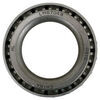





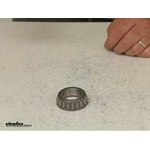























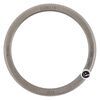
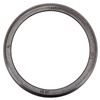
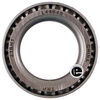

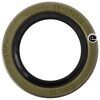

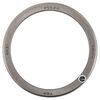














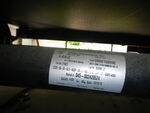









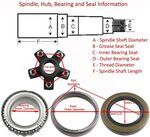
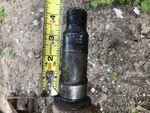
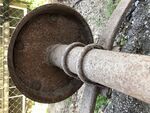
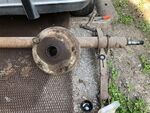
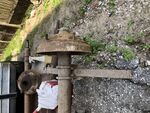
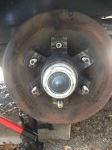
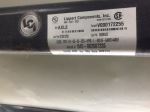
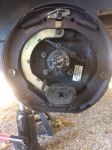
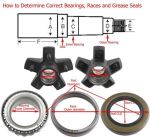
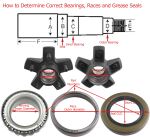

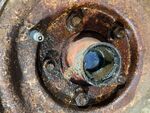

Katrina D.
5/8/2024
I am sorry that the bearings and seals showed up like that. Have any of them arrived with damage? Is everything there?